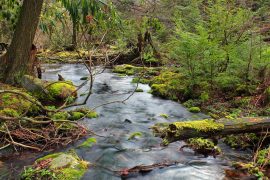Even if you’re not a Floridian, you’ve heard of the Everglades. It is a wild place, with a wild history filled with larger than life names, soaring rhetoric, backroom deals and intrigue. To some it is a place of surpassing beauty and others a pestilence-ridden swamp. Among the first accounts of this mysterious place was a description penned by a little known historian John Sparke in 1565 who was enlisted to record the voyage of English slave trader John Hawkins. Sparke’s report of the animal life occupying Florida includes a second hand account of a great four headed serpent with four legs which was as large as a spaniel. He also wrote about rumored “lions and tygers as well as unicornes.” [ref]Sparke, John. 1565. The Voyage Made By M. John Hawkins Esquire, 1565. Document number AJ-030.Wisconsin Historical Society, Digital Library and Archives.[/ref] While he couldn’t verify the “tygers” several Frenchmen in his company had pieces of the “unicorn hornes,” and of course everyone knows lions are the adversaries of unicorns, so it must follow that lions certainly must occupy Florida. Sparke’s account also included descriptions of cannibalism by the fierce Floridians, and these together with the serpents, lions and crocodiles may have provided sufficient disincentive for additional exploration for many generations.
As it happened, the interior gained a reputation for being impenetrable and remained a mystery to European settlers and early American explorers for nearly 300 years until Lt. J.C. Ives created a military map of South Florida in 1856 for use in the Third Seminole War. The image of South Florida was shifting. The new picture emerging of this vast wetland encouraged exploration and eventually inspired a nation. First, the inspiration was to a select few, specifically those with position, power, and means. These were lured with a promise of wealth and fame promised to any who tamed this wilderness. Today the inspiration is of a different stripe, one of appreciation for the beauty and inherent value of the Glades. Today it is not the few but the masses who are moved to stewardship and conservation of this land seen now as a national treasure. And self-identified Christians have long sat in both camps.
It is useful and I would say important for the Christian to wrestle with this subject. Isn’t the land and the wildlife that occupies it here for the sake of humanity? Shouldn’t these glades and other wild places serve our appetites if we so choose? After all, aren’t we called to subdue the earth, cultivate the wilderness and make it productive? Or are we here as stewards, to care for God’s garden, and to see that it is replenished? Are we stewards of creation, or called to rule over it? Or somehow, are we to be both?
In 1847, the secretary of the treasury charged Buckingham Smith, Esquire, with the task of assessing the practicability of plans to drain the Everglades (Pahayokee) and Big Cypress (Atseenahoofa) wetlands to “reclaim” the land for cultivation and habitation by a civilized population. Buckingham Smith Esq. submitted his Everglades “reconnaissance” report to the Secretary of the Treasury in 1848. And you might guess that the answer, in brief, was a resounding yes, we can and should drain South Florida. However, in reading the report, I was personally struck by what appear to be starkly conflicting views expressed by Buckingham as he eloquently expresses his appreciation for the beauty and grandeur he saw in the Everglades, even while maintaining the position that the land is utterly without value and urging its conversion to cropland.
“The appearance of the interior of the Everglades is unlike that of any region of which I have ever heard, and certainly it is in some respects the most remarkable on this continent…Lilies and other aquatic flowers of every variety and hue are to be seen on every side, in pleasant contrast with the pale green of the saw grass, and as you draw near an island the beauty of the scene is increased by the rich foliage and blooming flowers of the wild myrtle and the honeysuckle and other shrubs and vines that adorn its shores. The profound and wild solitude of the place, the solemn silence that pervades it, unless broken by the splashing of a paddle of the canoe or light batteau, with which only you can traverse the Pahayokee, or by the voices of your ‘compagnons du voyage’ add to awakened and excited curiosity, feelings bordering on awe.”[ref]Smith, Buckingham esq. 1847. Report of Buckingham Smith esq., on his reconnoissance of the Everglades 1846. George A. Smathers Libraries, University of Florida Digital Colletion. p. 51[/ref]
“But if the visitor [to the Everglades] is a man of practical, utilitarian turn of thought, the first and the abiding impression is the utter worthlessness to civilized man, in its present condition, for any useful or practical object, of the entire region…The Everglades are now suitable only for the haunt of noxious vermin, or the resort of pestilent reptiles. The statesman whose exertions shall cause the millions of acres they contain, now worse than worthless, to teem with the products of agricultural industry; to be changed into a garden in which can be reared many and various exotics…that man…will merit a high place in public favor, not only with his own generation, but with posterity.”[ref]Ibid., pp. 52, 54[/ref]
I suppose with even a modest amount of introspection, each of us would come to find that we also hold an assortment of apparently wildly contradictory views. Properly insulated, applying the requisite art of compartmentalization, we can hold these conflicting positions and remain at peace with ourselves. So while he recognized the stunning beauty found within nature, especially that possessed by the peerless Everglades, Smith’s primary concern was the concrete utility of the landscape. For many Christians, this approach to land use may seem to fall well within the charter laid out in the first chapter of the Bible: “Then God blessed them, and God said to them, ‘Be fruitful and multiply; fill the earth and subdue it; have dominion over the fish of the sea, over the birds of the air, and over every living thing that moves on the earth’” (Genesis 1:28).
Smith was faithful in fulfilling his charge to determine whether the Everglades and Big Cypress could be drained. He deemed it feasible, determining that cultivation of the drained landscape would be a boon to the nation’s economy. He spoke at length in lofty terms and with conviction about what should be done, describing the monumental social rewards which would be laid at the feet of those who actually undertook the task. Whether or not Buckingham Smith counted himself a Christian, whether it was a conscious determination or a subconscious expression, he appears to have fully embraced the notion that man has dominion over the earth, plainly wielding the authority to subdue it. Smith goes beyond this mere license though, expressing a near duty to drain and cultivate the land for the benefit of the people.
Subsequently, Congress incentivized the private sector to undertake this massive drainage project for the national good. Despite difficulties, the perseverance and ingenuity of the next two generations prevailed in draining the very wetlands this current generation is now working to restore. Let’s stop here just for a moment. Less than 150 years ago, wilderness was seen largely in utilitarian terms, something to be tamed, worthless so long as it failed to provide tangible benefits for mankind. It seemed inexhaustible to most, especially in the New World. As the ambition and appetite of powerful men and powerful nations chipped away at the wild frontiers, eventually people noticed. This great shift in thought regarding the Everglades represents an understanding that nature has value even if it is not producing a crop which clothes or feeds the human population. However, the primary argument for conservation today is not a Christian one. It is not a unified Christian voice clamoring to save this patch of creation for the sake of future generations, or for its own sake. The church has not come together to bemoan our poor track record of stewardship here in South Florida. Many of us have learned at great cost that not everything we are capable of doing, we should do. “All things are lawful for me, but all things are not expedient” (1 Corinthians 10:23). Just because we can drain the Everglades to raise sugar cane and oranges doesn’t mean we should. This was no desolate unproductive biblical wilderness. This was no God-forsaken land.
The prototypical biblical wilderness was a parched landscape, marked by its lack of rainfall and inability to support people, let alone produce lush vegetation. [ref]Nash, Roderick. 1967. Wilderness and the American Mind. 3rd Edition. Pg. 3[/ref]The first time the term wilderness was applied broadly in the public landscape was by John Wycliffe in his 14th century English translation of the Bible describing a desert. Over time this narrow definition was broadened and came to encompass all uninhabited, unaltered natural lands.[ref]Ibid.[/ref] So when Christians read the English Bible, they read about the “biblical wilderness,” about wastelands with no human value. Compared to a biblical wilderness, the Everglades was and still is a rich garden. In his report to congress, Buckingham included a letter from S.R. Mallory, Esquire, who described the Everglades in this way: “The woods and streams abound with game and fish, frost is rarely seen…The most indolent man I ever knew prospered there.”[ref]Smith, Buckingham esq. p. 63[/ref] In fact, thousands of Native Americans called the Everglades and Big Cypress home. This wilderness was their garden, their sanctuary. Drainage would pave the way for crops and people would follow. Like the campaign to eradicate the bison from the west, the draining of the Pahayokee also held a military motivation to prevent a fourth Seminole War.
Wealth, fame, food and military security—it is often hard to relate to the scale of these outsized motives driving land use throughout the history of the Everglades. The environmental movement wisely appeals to the utilitarian and economic-minded segment of the population of conservation lands in the discussion of ecosystem services. Sustainability encompasses the long view of food, economic and even military security, but often fails to motivate in the near term. But for me, and I would hope for all who count themselves among the followers of Christ, we should recognize the beauty found in the natural world. To realize that even if we fail to understand the role of each component, even Smith’s “noxious vermin” and “pestilent reptiles,” they do have a purpose. I would hope each of us would be hounded by an unshakable feeling of responsibility to take up the dual task given to Adam in Genesis, to work the garden and to take care of it. We have the capacity to be either benevolent stewards, or despots. May we choose wisely.





